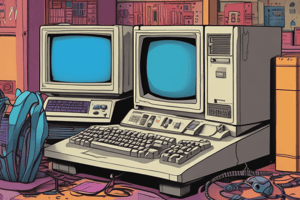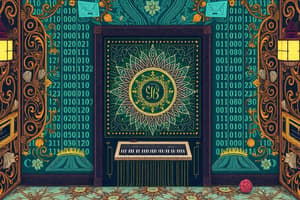Podcast
Questions and Answers
What is the primary function of the Central Processing Unit (CPU) in a computer?
What is the primary function of the Central Processing Unit (CPU) in a computer?
- Executes instructions and performs calculations (correct)
- Input/Output interactions with users and devices
- Temporary storage for data and applications
- Permanent storage for data and programs
What was the primary use of the term 'computer' in the 17th century?
What was the primary use of the term 'computer' in the 17th century?
- To describe a person who performed calculations (correct)
- To describe a network of computers
- To describe a machine that performed calculations
- To describe a device that stored information
What is the primary function of a Storage Drive in a computer?
What is the primary function of a Storage Drive in a computer?
- Executing instructions and performing calculations
- Permanent storage for data and programs (correct)
- Input/Output interactions with users and devices
- Temporary storage for data and applications
What is the primary characteristic of a Laptop Computer?
What is the primary characteristic of a Laptop Computer?
What is the primary function of the Operating System (OS) in a computer?
What is the primary function of the Operating System (OS) in a computer?
What is the primary characteristic of a Server?
What is the primary characteristic of a Server?
What is the primary characteristic of the 1st Generation of Computers?
What is the primary characteristic of the 1st Generation of Computers?
What is the primary function of Input/Output Devices in a computer?
What is the primary function of Input/Output Devices in a computer?
Flashcards are hidden until you start studying
Study Notes
Definition and History
- A computer is an electronic device that can store, process, and communicate information.
- The term "computer" was first used in the 17th century to describe a person who performed calculations.
- The first mechanical computer was developed in the 19th century by Charles Babbage.
- The first electronic computer was developed in the 1940s, using vacuum tubes.
Components
- Hardware: physical components of a computer, including:
- Central Processing Unit (CPU): executes instructions and performs calculations.
- Memory (RAM): temporary storage for data and applications.
- Storage Drive: permanent storage for data and programs.
- Input/Output Devices: keyboard, mouse, monitor, etc.
- Software: programs and operating systems that run on the computer, including:
- Operating System (OS): manages hardware and provides a platform for applications.
- Applications: programs that perform specific tasks, such as word processing or web browsing.
Types of Computers
- Desktop Computers: designed for stationary use, often used for heavy processing and gaming.
- Laptop Computers: portable and designed for mobile use.
- Tablets: touch-sensitive devices that combine features of computers and smartphones.
- Smartphones: handheld devices that combine features of computers and phones.
- Servers: specialized computers that manage and provide access to resources over a network.
Functions
- Processing: executes instructions and performs calculations.
- Storage: stores data and programs.
- Input/Output: interacts with users and devices.
- Communication: connects to other devices and networks.
Generations of Computers
- 1st Generation (1940s-1950s): vacuum tubes, used for scientific calculations.
- 2nd Generation (1950s-1960s): transistors, smaller and faster than vacuum tubes.
- 3rd Generation (1960s-1980s): integrated circuits, led to the development of microprocessors.
- 4th Generation (1980s-present): microprocessors, led to the development of personal computers.
Definition and History
- A computer is an electronic device that stores, processes, and communicates information.
- The term "computer" originated in the 17th century to describe a person who performed calculations.
- Charles Babbage developed the first mechanical computer in the 19th century.
- The first electronic computer was developed in the 1940s using vacuum tubes.
Components
- Hardware consists of physical components, including:
- Central Processing Unit (CPU) for executing instructions and performing calculations.
- Memory (RAM) for temporary storage of data and applications.
- Storage Drive for permanent storage of data and programs.
- Input/Output Devices, such as keyboard, mouse, and monitor.
- Software includes programs and operating systems, including:
- Operating System (OS) to manage hardware and provide a platform for applications.
- Applications, such as word processing and web browsing.
Types of Computers
- Desktop Computers are designed for stationary use, often for heavy processing and gaming.
- Laptop Computers are portable and designed for mobile use.
- Tablets combine features of computers and smartphones, using touch-sensitive screens.
- Smartphones combine features of computers and phones, fitting in a handheld device.
- Servers are specialized computers managing and providing access to resources over a network.
Functions
- Processing executes instructions and performs calculations.
- Storage stores data and programs.
- Input/Output interacts with users and devices.
- Communication connects to other devices and networks.
Generations of Computers
- 1st Generation (1940s-1950s) used vacuum tubes for scientific calculations.
- 2nd Generation (1950s-1960s) used transistors, which were smaller and faster than vacuum tubes.
- 3rd Generation (1960s-1980s) used integrated circuits, leading to the development of microprocessors.
- 4th Generation (1980s-present) used microprocessors, leading to the development of personal computers.
Studying That Suits You
Use AI to generate personalized quizzes and flashcards to suit your learning preferences.




